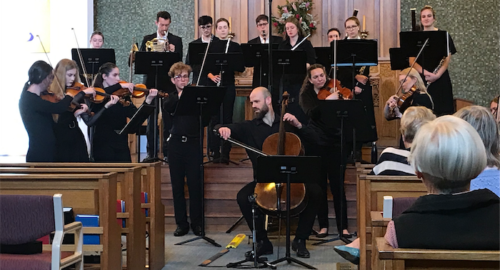
Music / Tchaikovsky and Haydn Cello Concerti with Chris Pidcock, Canberra Sinfonia, at Wesley Uniting Church, August 31. Reviewed by TONY MAGEE
One of the many delights in attending a concert of well prepared and played classical music, is the prospect of hearing some undiscovered jewel.
In playing the “Symphony in G minor” by one Antonio Rosetti, (1750 – 1792), Canberra Sinfonia brought to the audience a little known work of substance and quality which reflects very much the style of contemporaries Mozart, Haydn and Salieri.
Born Franz Anton Rösler in Bohemia, he had by 1773 Italianised his name in the belief that this would further his acceptance and credibility as a serious European composer. Ironically, Mozart achieved a great deal of his fame and success and launched many major works in Prague, which helped greatly in establishing that city as one of the great musical and cultural centres of Europe.

The concert opened with Pidcock as cello soloist in the “Cello Concerto No. 1” by Haydn. After a slightly tentative beginning, the orchestra came together as one, as Pidcock paved the way and swept his players along with a commanding presence, tone and sonority of such beauty, depth and feeling.
After interval, we were treated to the highlight of the program, Tchaikovsky’s “Variations on a Rococo Theme”. The orchestra swelled to its capacity of about 20 players for this work, delivering richness, phrasing and an emotional depth of mature insight. Pidcock’s playing was masterful, confident and a joy to listen to and behold.
As an ensemble, Canberra Sinfonia have progressed a great deal since inception in July 2018. Further refinement awaits in rhythmic accuracy during entries and cadence points. But Canberra now has a chamber orchestra of which we can be proud.
The concert closed with a contemporary work by Giovanni Sollima entitled “Hell II”. A title at odds with the setting in which we were all gathered, the music itself was reflective and gentle, wavering between harmonies of beauty and discord, which were resolved through sliding, glistening string work.
Part of the success of this event was the choice of instrument itself. Leaving his own German Schnabel cello behind, Pidcock instead gained access to an Italian period instrument from 1710, made in Bologna by Guidante. Its dark, almost mysterious tones in the lower and middle registers ravished the ear, whilst its high register delivered sounds of such a delicate nature.
The instrument is currently for sale, and Pidcock fears it may go to an overseas buyer. He would like to see it remain here in Australia, so audiences and the best players alike can enjoy it and marvel at its secrets.
With such an instrument in the hands of one so skilled as Chris Pidcock, history speaks and we all marvelled and cherished the moments.
Who can be trusted?
In a world of spin and confusion, there’s never been a more important time to support independent journalism in Canberra.
If you trust our work online and want to enforce the power of independent voices, I invite you to make a small contribution.
Every dollar of support is invested back into our journalism to help keep citynews.com.au strong and free.
Thank you,
Ian Meikle, editor








Leave a Reply